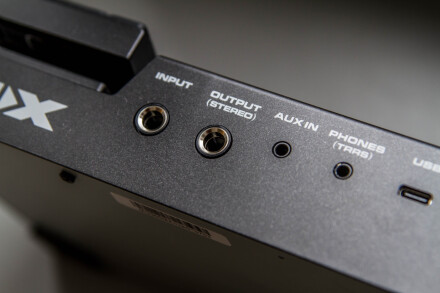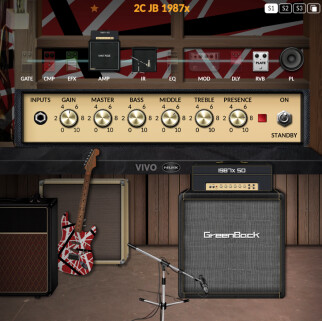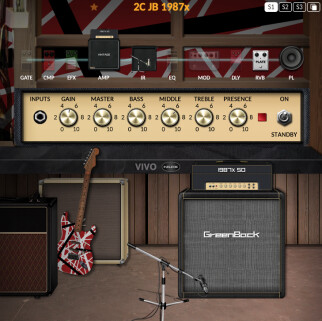The MG-300 from nUX is a digital multi-effects pedalboard for guitar. It was first released in July 2020, but it wasn't until February 2025 that the brand evolved it. Externally, the device remains almost identical, with only a few slight modifications to report. On the other hand, nUX has pulled out all the stops in terms of updating its software.
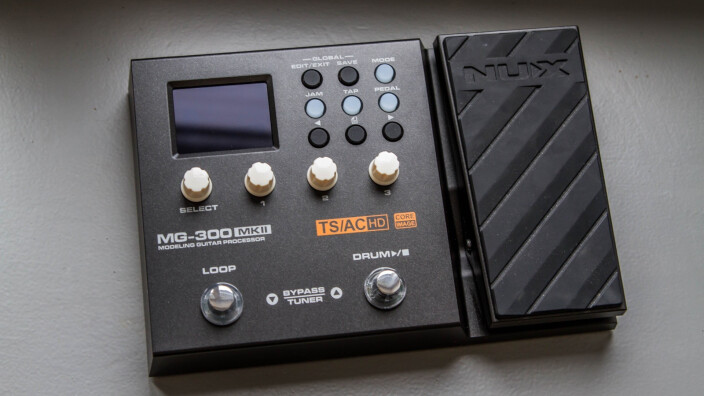
A compact, but robust design: what changes with the MG-300 MKII
The MG-300 MKII follows the format of the first-generation MG-300 with two footswitches, an assignable expression pedal, nine knobs, a notched encoder that doubles as a pushbutton and three encoders labeled 1, 2 and 3. On the first version, these encoders were called Gain, Level and Master. The various knobs are organized as follows:
- Edit/Exit: accesses the editing menu
- Save: button to save a preset
- Mode: lets you choose between Studio Direct, Combo Front, Stack Front, Combo Rear or Stack Rear modes
- Jam: provides access to the built-in Looper and drum machine
- Tap: button for tapping the tempo of the drum machine and delay
- Pedal: lets you configure the expression pedal (Wah, EFX, Amp, Mod, Delay, Reverb or unassigned)
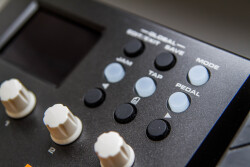
- A mono input on a 1/4-inch jack
- One stereo output on a 1/4-inch TRS jack
- One auxiliary input on an 1/8-inch (3.5mm) mini-jack
- One OnTheGo headphone output on an 1/8-inch TRRS mini-jack
- A USB-C port for accessing the software editor, using the device as an audio interface and updating firmware
- A power button
- A power plug
A tuner is also built into the pedalboard, accessed by pressing both footswitches simultaneously. This tuner allows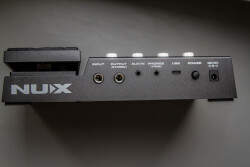
If the front and rear panels look familiar, that’s normal – they’re identical to those found on the MG-101 already tested in the columns of your favorite blue site. The MG-300 MkII, on the other hand, benefits from a much more solid chassis, footswitches and expression pedal. The footswitches seem robust, as does the expression pedal. Despite looking much more solid, the chassis is still plastic, which is a shame.
No surprise, nUX has implemented its TS/AC-HD (True Simulation of Analog Circuit) algorithm, which is in charge of modeling effects and amps. The manufacturer’s technical data is as follows:
- Sampling frequency: 48 kHz
- Digital-to-analog conversion: 32-bit
- Frequency response: 20 Hz – 20 kHz
- Dynamic range: 106 dB
- Input level: 8dBu
- Output level: 8dBu
MG-300 MKII: striking improvements and new features
For this MkII version, nUX has designed a few improvements that make it a much more efficient and professional tool. Overall latency has been reduced, which drastically improves the gaming experience. Each preset now has three “Scenes, ” secondary presets between which you can switch without mute. This feature will be much appreciated in a live context, where you want to change sounds without experiencing pops or muting. I’ve used Scenes to concoct variations of the main preset (for example, Scene 1 corresponding to a Plexi, Scene 2 corresponding to the same amp, boosted by a Tube Screamer). This is a very useful new feature, allowing you to organize the different sounds you need during the same song.
The Patch Level block we first discovered on the MG-101 has returned on the MG-300 MkII. This block can be placed anywhere in the audio chain; it lets you define maximum and minimum volumes and adjust the overall patch level. This block can be helpful if you simply want to turn up the volume of a patch for a solo sound, for example.
All blocks (Noise Gate, Comp, EFX, Amp, IR, EQ, Mod, Delay, Reverb and Patch Level) can now be moved anywhere in the audio chain. This was impossible on the MG-101, which has a fixed chain. The footswitches can also be configured in different ways:
- Preset: browse the various presets using the two footswitches
- Scene: stay on the same preset and browse its different scenes thanks to the two footswitches
- Scene + Preset: the left foot switch is used to browse scenes, and the right one to move on to the next preset
You can choose whether or not to activate Scene 3, which is handy. I personally only used two scenes per preset and therefore chose the Scene + Preset mode, disabling Scene 3. The expression pedal can be assigned to effects, which can be very inspiring. I particularly enjoyed controlling the reverb level directly by foot. The MG-300 MkII has only one EFX block, one Mod block and one Delay block. But nUX has thought of everything, and the Comp block can become an EFX block, the EFX block can become a Mod block and the Reverb block can become a Delay block. So you can easily use two EFX effects, two modulation effects or two 
The MG-300 MkII integrates 44 effects, 25 amps and 36 impulse responses (25 guitar speakers, 8 bass speakers and 3 acoustic guitar impulse responses). On the recording simulation side, there’s a choice of four microphones: Sennheiser E-906, Shure SM57, Neumann U87 and AKG C-414. If you prefer to use your own IRs, there are 24 built-in slots in which you can place them. The looper has been updated and can record 60 seconds in stereo or 120 seconds in mono. The drum machine has ten different styles (Rock, Country, Metal, Blues, Funk, Metronome, Ballad, Pop, Reggae and Electro) with seven variations per style. You can adjust the tempo between 40BPM and 240BPM and apply three-band equalization to the drum machine.

Handling and first impressions: what is this pedalboard really worth?
After taking the MG-300 MkII out of its cardboard box, I immediately connected it to my computer to access the QuickTone software. Indeed, as with the MG-101, the ergonomics are rather poorly thought out, and editing presets without going through the editing software is a real pain. NUX asked professional musicians to make some presets, which was a good idea. As a result, you can quickly get a sense of the device’s capabilities. You’ll find presets by ChopTones, Leon Todd, Leo Gibson and Jimmy Lin. After listening to a few of these sounds, I set about making my own, as usual.

- Leon Todd Crunch00:52
- Leon Todd More00:50
- Leon Todd Way More01:15
As with the MG-101, I was enthusiastic about the Vintage-oriented sounds. The Fender amp models are all very successful, especially the Vibro King and Super Reverb. I found these amp models to be successful emulations. The Vox and Hiwatt models are, in my opinion, much less successful and display a not-very-pleasant digital side. As for effects, the new Shimmer reverb is nice but not incredible. The saturation effects are well done overall, especially the Tube Screamer modeling. Temporal effects and modulation effects are good overall. The two compressors, which are models of the MXR Dyna Comp and Ross Compressor bring a nice tone and quite a bit of sustain.

- JB Deluxe Reverb + Tube Screamer01:29
- JB Deluxe Tweed + Blues Driver (Cab 110 puis 410)01:19
- JB AC30 Phaser puis AC1501:34
- JB Hiwatt Chorus + Fuzz Face01:47
- JB Mesa Boogie MkI Shimmer + Tube Screamer01:33
- JB Super Reverb01:11
- JB VibroKing + Tube Screamer01:43
When it comes to British-saturated sounds, there’s plenty to choose from, but not all amps are created equal. While the JCM 800 modeling is very successful, the various Plexi models are much less so, displaying a very cold, digital rendering. NUX has even modeled a JCM 200 DSL 100, the flagship amp of the early 2000s.
I completed the MG-300 MkII overview with the big, saturated sounds. Here again, there’s plenty to choose from, with models of Mesa Boogie, Diezel, Bogner and Soldano. As on the MG-101, it’s Bogner Uberschall’s modeling that really stands out if you’re looking for a really big sound.

- JB Friedman HBE Stereo Chorus + Tube Screamer01:41
- JB DSL 10001:08
- JB JCM800 + Katana Boost01:09
- JB Plexi 100 + RC Boost02:08
- JB Plexi 50 Watts + DynaComp01:34
- JB Uberschall Stereo Chorus01:13
- JB Mesa Dual Rec Tube Screamer01:22
- JB Soldano DynaComp01:19
- JB Mesa Boogie MkI Shimmer + Tube Screamer01:33
- JB Diezel VH4 Plate Reverb01:01
While the tones developed by the MG-300 MkII are nothing new, the device offers a far superior playing feel to that offered by the MG-101. You can feel that the manufacturer has revised its design and improved the algorithm, inputs and outputs of this new pedalboard.
FAQ
1. What are the main improvements of the MG-300 MKII compared to the first version?
The MG-300 MKII brings several new features, including reduced latency, the addition of Scenes to change sounds without clipping, the ability to reorganize effects blocks and greater robustness of the chassis and footswitches.
2. Have the ergonomics of the MG-300 MKII been improved?
Not really. The interface remains unintuitive, and editing presets without using the Quick Tone software is complicated. On the other hand, the flexibility of the footswitches and the addition of new features partly compensate for this shortcoming.
3. Can the MG-300 MKII be used as an audio interface?
Yes, thanks to its USB-C port, it can be used as an audio interface for recording and editing sounds on a computer.
4. How good are the amp and effects models?
The Fender amp models are very good, as are some of the high-gain sounds (Bogner, Soldano). On the other hand, the Vox and Hiwatt models seem more artificial.
5. Is the expression pedal assignable to multiple parameters?
Yes, it can be configured to control effects such as wah, volume, modulation, delay and reverb.
Technical characteristics of the nUX MG-300 MKII
- Sampling frequency: 48 kHz
- Digital-to-analog conversion: 32-bit
- Frequency response: 20 Hz – 20 kHz
- Dynamic range: 106 dB
- Inputs and outputs :
- 1/4" mono jack input
- 1/4" mm TRS stereo jack output
- 1/8-inch (3.5 mm) mini-jack auxiliary input
- 1/8-inch TRRS mini-jack headphone output
- USB-C port (audio interface, firmware update)
- Effects and modeling :
- 44 built-in effects
- 25 modeled amps
- 36 impulse responses (IR)
- Possibility of importing your own IR (24 slots)
- Looper:
- Recording up to 60 seconds in stereo, 120 seconds in mono
- Rhythm box :
- 10 styles with seven variations each (rock, blues, metal, etc.)
- Tempo adjustable from 40 BPM to 240 BPM





